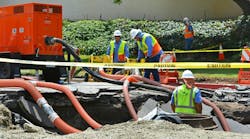New Storm Water System Will Clean Up Michigan Storm Water
Grand Haven, Mich., officials are working with the Michigan Department of Natural Resources to launch an underground chamber system that removes harmful contaminants from storm water before it reaches the Grand River.
Construction crews are installing the technology under new parking lots in the first block of Washington Avenue's south alley, according to a report in the Muskegon Chronicle.
The installation of three underground chambers is part of a $3.3 million improvement project to the alley. The project includes the installation of new lights, landscaping, benches and the burial of overhead utility lines from Harbor Drive to Third Street..
Downtown advocates say the project's first phase, which will be completed from Harbor Drive to First Street this fall, will make the alley more user-friendly for shoppers and visitors.
DNR officials have said they are excited about the technology. storm water is collected in large chambers with gravel bases and a porous cloth. The solid contaminants are collected in the cloth barrier and the water drains through the gravel and into the ground.
"The water stays on-site and drains into the natural water table," said George Bosnjak, executive director of Grand Haven's Main Street DDA. "But all the pollutants like break dust are caught in the storm chamber."
Twice a year, the city's department of public works will use large vacuums to removed the solid contaminants, Bosnjak said.
City Manager Patrick McGinnis said an experimental permeable asphalt will be used on one of the parking lots. City leaders will monitor how the asphalt weathers over the next several years and will report their findings to the state.
Each underground chamber costs $40,000. The project is being funded through a downtown tax increment financing plan. Some grant money from the Michigan Department of Environmental Quality could be used for the project, Bosnjak said.
Whitehall is using a similar storm water treatment system for a major street reconstruction project on Division Street, which is nearly completed. The storm water-interceptor along Division will feature two catch basins that will help keep oil, gasoline, sand and salt from flowing into Bush Creek, which empties into White Lake.
Similar interceptors are being used in Grand Haven as well.
McGinnis said Grand Haven officials are working with the MDEQ to get permits to install "green" technology for storm water elsewhere in Grand Haven over the next two years.
A $500,000 state grant will help the city launch the Best Management Practices program that focuses on environmentally friendly ways to remove contaminants from storm water. The program is part of the state's Clean Michigan Initiative.
McGinnis said the 400 blocks of Slayton and Grant are slated to receive upgrades, including underground chambers, over the next two years to help deal with flooding issues.
Similar projects on Grand Avenue and Pine Ridge will help alleviate flooding issues near sewer lift stations that can overflow into the storm water system, McGinnis said.
Right now, the downtown parking lot is the only "green project" on the city's list that has received state approvals. City officials are working to obtain state the green light for projects on Slayton, Grant, Grand and Pine Ridge, McGinnis said.
"There are unique ways we can take care of that storm water and hopefully, treat it better and get rid of it," McGinnis said.
Source: MC


